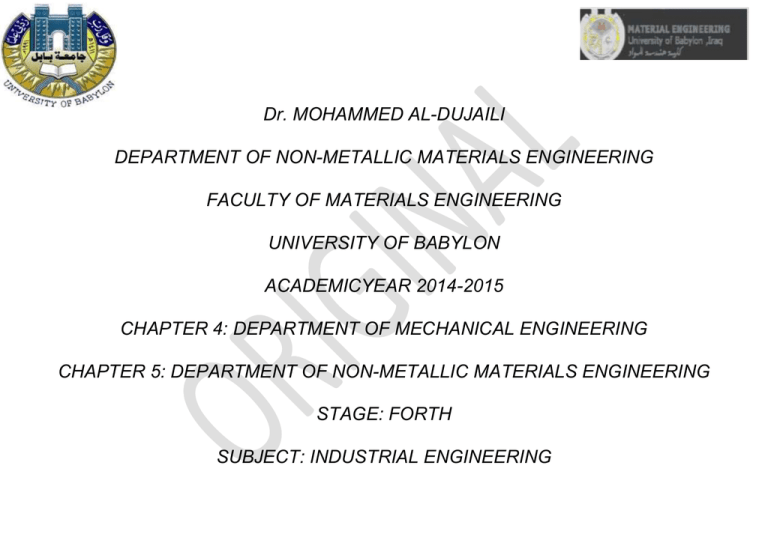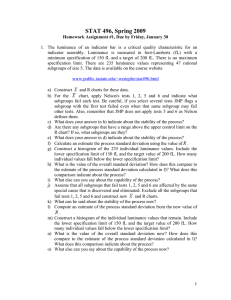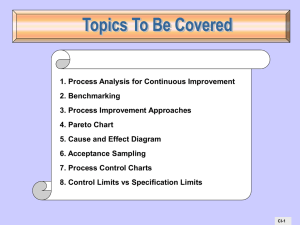Dr. MOHAMMED AL-DUJAILI DEPARTMENT OF NON-METALLIC MATERIALS ENGINEERING FACULTY OF MATERIALS ENGINEERING
advertisement

Dr. MOHAMMED AL-DUJAILI DEPARTMENT OF NON-METALLIC MATERIALS ENGINEERING FACULTY OF MATERIALS ENGINEERING UNIVERSITY OF BABYLON ACADEMICYEAR 2014-2015 CHAPTER 4: DEPARTMENT OF MECHANICAL ENGINEERING CHAPTER 5: DEPARTMENT OF NON-METALLIC MATERIALS ENGINEERING STAGE: FORTH SUBJECT: INDUSTRIAL ENGINEERING Quality Control, Six Sigma, Process Capability Overview quantum leap, thereby requiring proper refocusing and rethinking. This is targeted seriously towards firms acquiring Knowledge Systems (KS) in order to nurture the employees’ capabilities. Therefore, to enhance performances and their highly creative direction takes consideration of QE and KS and disciplines complementary to each other. Additionally, the flow of operations and activities of the KS through the application of quality engineering (QE) principles is according to the view of Japanese engineer Taguchi. This aims to achieve good quality in the product design and processes, and also to anticipate problems that may occur before the shipping of the products. Statistical Quality Control Statistical quality control defined as concept is used to explain the set of statistical tools which is used by quality professionals, in line with engineers’ aspirations that focus on reducing the proportion of defective units and the volume of complaints. In view of that, Statistical quality control can be divided into three broad categories: Descriptive statistics are used to describe quality characteristics and relationships. Included are statistics such as the mean, standard deviation, the range, and a measure of the distribution of data. Statistical Process Control (SPC) involves inspecting a random sample of the output from a process and deciding whether the process is producing products with characteristics that fall within a predetermined range. SPC answers the question of whether the process is functioning properly or not. Acceptance sampling is the process of randomly inspecting a sample of goods and deciding whether to accept the entire lot based on the results. Acceptance sampling determines whether a batch of goods should be accepted or rejected. Types of Quality Control There is a two types of quality control charts which use in analysing quality for fault detection in operations of the manufacturing through statistical monitoring and process-controlling charts, and as follows; Control Charts for variables: this method collects measurements on large numbers of process variables; multivariate statistical methods for the analysis, monitoring and diagnosis of process-operating performance have received increasing attention. It is an extension to a traditional Shewhart method the process been acceptable at the following limits. In the degree of confidence its value (68.3%) becomes the accepted limit ( + M). In the degree of confidence its value (95.45%) becomes the accepted limit (2 + M). In the degree of confidence its value (99.33%) becomes the accepted limit (3 + M). Most studies have adopted the degree of confidence (99%) to become the acceptable limit because the chance factors are equal to three standard deviations (3 ). On this side, there are set from control charts in this scope including Mean chart ( X ) and Range chart (δ-chart) Standard deviation chart Standard deviation chart by using of factor (A ) and its symbol (δchart-A). Accordingly, the study will use the standard deviation chart (δ-chart). This is because most of the engineering industries are using this chart due to the changes being small in proportion, to limit its disproportion, as well as to a range chart. The steps to both charts are as follows Account of an average chart to standard deviation As seen from the above explaining, the key equation signals can be written as ( j 1.2.3......n) .can be written as eq. n X Xij N i 1 Where ( ) = the number of readings or observations in each subgroup, = Largest Value, (X ) = Smallest Value. Or: R Li Si (R ) n X Xi K i 1 Where Xi : The arithmetic average of the observations. X : Average of computational averages. K : The number of sub-groups. U .C.L X 3 / n Where (U .C.L.) represents upper control limit, is calculated as eq. above. R / d2 Where, ( D2 ) represent the size of the impurities, and depends on the basis of the test hours in the day. R n R i 1 i /IK L.C.L X 3 / n Where, ( Ri ) is represents the difference between the largest and the lowest value in each sub-group, (R) the arithmetic average of the range, (K ) the number of sub-groups in test. Accordingly, it be account of a range chart to standard deviation can be written as eqn. UCL D 4 R CL R LCL D3 R Where (CL) represents center line for a average chart and range chart, ( D4 , D3 ) represents Values are fixed in the values table derived according to the number of observations. Control Charts for Attributes: Control charts can be used in attribute inspection, where the unit of measurement is a distinct value. Therefore, control charts are concerned with two types of attributes ‒ the percentage defective (P-chart) or the defects per unit (C-chart). Process production capability Process capability compares the output of an in-control process to the specification limits by using capability indices. The comparison is made by forming the ratio of the spread between the process specifications (the specification “width”) to the spread of the process values, as measured by six process standard deviation units (the process “width”). Accordingly, the process capability index uses both the process variability and the process specifications to determine whether the process is capable. Comparing the output of a stable process with the process specifications enables us to make a statement about how well the process meets those specifications. However, the capable process is one where almost all measurements fall inside the specification limits. Fig. below gives process specification limits to the production methods. Fig. process specification limits to the production methods However, the capability of the process calculates by using the following eqn. ( Xi X ) n 1 2 , R d2 Where ( ) is standard deviation, is extracted from either the mathematical mean or range. 6 6 6R * R , 6 d2 d2 The process capability index ( CP ) is calculated by eqn. X Ls US X T CPK min , CP 3 6 3 Where ( CP ) is process capability ratio, ( US ) is upper specification, and ( LS ) is lower specification. Meanwhile, tolerance ( T ) can be calculated using equation. Tolerance ( T ) = upper specification – lower specification. However, if the CP is greater than 1, the process is capable. If the tolerance limits of the process are greater than the actual extent of the outputs, and if CP is less than 1, the process will produce products outside the control limits. An increase in this ratio represents an increase in process capability. Table below shows the relationship between the indicator of the process capability and the number of defects per million items. Table: The relationship between the process capability indicator and the number of defects per million Process capability indicator (Expansion Number of defects Expansion of tolerance area per million items of the area of tolerance/ (6𝜎) 4 5 6 7 8 0.67 0.83 1 1.17 46000 12000 3000 500 1.33 60 9 1.50 7 Note that the best indicator for production process capability is achieved when the disparity is equal to 8 in standard deviation. This means that the number 1.33 is the best indicator of process capability (CP), because any change or removal in mean will not affect the dispersion of production, which will remain within the limits allowed. There are a three cases to take action after the account of capability process; 1. If was 1.33 < CP In this case, the audit should be within the limits of the specification or production process , or both, in order to reduce the cost of production, due to is not there needed for this high accuracy. 2. 𝐼𝑓 𝑤𝑎𝑠 1.33 > 𝐶𝑃 > 1 This means that the ideal situation does not call for any action. 3. 𝐼𝑓 𝑤𝑎𝑠 1 > 𝐶𝑃 This means taking measures to improve the condition of the machinery or production line as well as the inspection of production by 100% to isolate the defective products. Mean chart ( X ) and Range chart To find ( X )chart must be do the following steps; - Find average values for each subgroup n X xi i 1 N xi→ total of the values observed in subgroup N → Number of readings or observations in the sub-group - Find range value for each sub-group R X ( L arg est Value) X ( Smallest value) Or Find the average of the averages as follows; n X x i i 1 K →Average of averages calculations X →total of the values observed in subgroup K → Number of a inspection days - Find range value ( R ) for of ranges X R ( R1 R2 Rn n R R i 1 K i XiU XiL limits of the control for the average chart as follows U .C.L X RA2 Upper Control Limit C.L X L.C.L X RA2 Lower Control Limit A2 →A constant value in Table of statistical values depends its amount on the size of the sample drawn per day Note: In the case finding groups outside the control limits will exclude these groups according to the following equation; n X New X i Xd i 1 m md R Chart U .C.L D4 R , R New Ri Rd m md C .L R L.C.L D3 R D3 & D4 could find them in Table of statistical values


